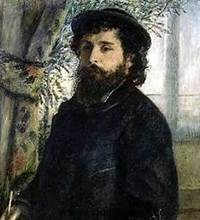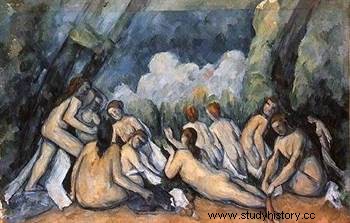 Originally from Provence,Paul Cézanne (1839-1906) is a French painter famous for his compositions of landscapes and still lifes, and considered the father of modern painting. Towards the end of the 19th century, however, it was in isolation and anonymity that he produced his major works, in search of a new pictorial construction that distanced him from Impressionism. One of his favorite subjects is the montagne Sainte-Victoire , located near Aix-en-Provence; he painted about twenty versions of it from 1883. The work of Paul Cézanne played a major role in the birth of modern art and in particular in that of the cubist movement.
Originally from Provence,Paul Cézanne (1839-1906) is a French painter famous for his compositions of landscapes and still lifes, and considered the father of modern painting. Towards the end of the 19th century, however, it was in isolation and anonymity that he produced his major works, in search of a new pictorial construction that distanced him from Impressionism. One of his favorite subjects is the montagne Sainte-Victoire , located near Aix-en-Provence; he painted about twenty versions of it from 1883. The work of Paul Cézanne played a major role in the birth of modern art and in particular in that of the cubist movement.
Paul Cézanne, between romanticism and realism
Born in Aix-en-Provence on January 19, 1839, Paul Cézanne was the son of a wealthy bourgeois from Aix society. With his childhood friend Émile Zola (two years his junior) whom he met at college, he showed an early interest in humanistic disciplines. After studying law, Paul Cézanne was granted a small pension by his family and left to study painting in Paris. Between 1861 and 1869, alongside Émile Zola, he shared his life between Aix and Paris. There, he discovers and is passionate about the work of Eugène Delacroix, of a romantic eclecticism, and that of Gustave Courbet, of a revolutionary realism.
Enrolled in 1862 at the Swiss Academy in Paris (where he met Camille Pissarro), he also liked to study the manner of artists such as Titian, Pierre Paul Rubens, Diego Vélasquez or Caravaggio, when he goes to the Louvre Museum. From 1863, Paul Cézanne regularly offered his paintings to the jury of the Salon, which systematically refused to exhibit it, with the exception of the year 1882 (this is how he participated in particular in the Salon des refusés of 1863) .
 Paul Cézanne's first paintings reveal his taste for allegories. The nostalgia of a romanticism is expressed there in a heavy way, strong in matter, pastiche and recapitulating the previous generation. However, even as Émile Zola continued his quest for a realistic novel, Paul Cézanne gradually became interested in the representation of reality by painting portraits and still lifes, without concern for thematic idealization or stylistic affectation. . This is the case with the Black Marble Pendulum (1869-1870, private collection, Paris), a painting in which the painter, by omitting the representation of the hands, freezes time and marks the physical gravity of the objects.
Paul Cézanne's first paintings reveal his taste for allegories. The nostalgia of a romanticism is expressed there in a heavy way, strong in matter, pastiche and recapitulating the previous generation. However, even as Émile Zola continued his quest for a realistic novel, Paul Cézanne gradually became interested in the representation of reality by painting portraits and still lifes, without concern for thematic idealization or stylistic affectation. . This is the case with the Black Marble Pendulum (1869-1870, private collection, Paris), a painting in which the painter, by omitting the representation of the hands, freezes time and marks the physical gravity of the objects.
The influence of Impressionism on Cézanne
The most decisive influence received by Paul Cézanne was that of Camille Pissarro, who encouraged him to settle in 1872 in Auvers-sur-Oise (at the Doctor Gachet). Camille Pissarro teaches the young painter from Aix the technique of plein air painting, negatively qualified as impressionist by critics from 1874. With Claude Monet, Auguste Renoir and a few others, Camille Pissarro forged a style which supposes a rapid and subjective work , using small touches of pure color, to make the evidence of life running. These artists hope to capture nature's most ephemeral notes and record their own—equally fleeting—visual interpretation of each moment.
Under this patronage (from 1872 to 1873), Paul Cézanne abandoned dark tones for bright hues and increasingly oriented himself towards scenes of rural life, where the color takes precedence over the model. Under the friendly pressure of Camille Pissarro, Paul Cézanne took part in some of the Impressionist exhibitions (in particular the first in 1874, organized by Félix Nadar) which broke, through the economic and aesthetic desire to escape traditional artistic circuits, with the officiality. However, faced with the hostility and incomprehension experienced in particular by his paintings, Paul Cézanne moved away from his Parisian companions between the end of the 1870s and the beginning of the 1880s, and spent most of his time in Aix. -in Provence.
From the constructive period...
From 1882, Paul Cézanne stopped working closely with Camille Pissarro. Shortly after, he took umbrage at the Work of Émile Zola (1886), a novel in which the writer painted the portrait of a realist painter, Claude Lantier, unable to capture reality other than in death. Appalled by his friend's feelings for him, Paul Cézanne broke with his oldest admirer. The same year, he inherited his father's fortune, thus acquiring a financial well-being that allowed him to isolate himself and concentrate on his work, outside of all other formal or material contingencies.
 The years 1880-1890 are those of the maturity of the "Cézanne" style. During this prolific period, the artist continued to carry out studies from nature in the Impressionist movement, while seeking a way to break with a painting of fleeting nuance, for a painting of duration - in other words, to substitute for time which passes in the changing light of day the eternal weight of objects.
The years 1880-1890 are those of the maturity of the "Cézanne" style. During this prolific period, the artist continued to carry out studies from nature in the Impressionist movement, while seeking a way to break with a painting of fleeting nuance, for a painting of duration - in other words, to substitute for time which passes in the changing light of day the eternal weight of objects.
Paul Cézanne wants to mark the construction of pictorial space rather than the appearance of the moment, without sacrificing the evocative power of colors. In order to meet this requirement, it systematizes the method of the directional key. The touch, in addition to information on the color and the material of an object, will render, by its arrangement and its orientation, the volume of the object in the general architecture of the canvas. With a bundle of brushstrokes placed vertically for the painting of a tree, and brushstrokes placed horizontally for the rendering of the sea, Paul Cézanne draws directly in color, thus materializing the elements of reality with a geometric framework.
... At synthetic period
In the last years of his life, Cézanne's style evolved towards a simplification of forms, a geometry gradually dissolved into color. This is the case with the series of the Montagne Sainte-Victoire, where, using the impressionist process of graduated repetition of the motif, the artist proposes a reflection on the very notion of landscape by layering the perspective rendering of the planes (the Montagne Sainte -Victoire, view of Bibémus, 1898-1900, Baltimore Museum of Art).
The last part of his work is characterized by the placement of large portraits (Grandes Baigneuses series, 1898-1905, Museum of Art, Philadelphia; Barnes Foundation, Merion; Les Grandes Baigneuses, The National Gallery, London), in which human bodies become ample sculptural volumes structured by the modulations of color.
Paul Cézanne, from near anonymity to celebrity
 For many years, the work of Paul Cézanne was known only to his impressionist friends and a few artists like Vincent Van Gogh and Paul Gauguin. Working in almost complete isolation, the artist distrusts criticism and exhibitions. In 1895, however, Ambroise Vollard (an ambitious Parisian art dealer) organized an exhibition of the artist's works, which he continued to promote successfully for several years.
For many years, the work of Paul Cézanne was known only to his impressionist friends and a few artists like Vincent Van Gogh and Paul Gauguin. Working in almost complete isolation, the artist distrusts criticism and exhibitions. In 1895, however, Ambroise Vollard (an ambitious Parisian art dealer) organized an exhibition of the artist's works, which he continued to promote successfully for several years.
It was a revelation for many artists and critics, for whom it then became an immediate reference (Maurice Denis, Tribute to Cézanne, 1900, Musée d'Orsay) . Many young artists now travel to Aix-en-Provence to observe his work. Several important exhibitions followed (individual exhibition of the Salon des Indépendants in 1899, Salon d'Automne of 1904, 1905 and 1906) and, at his death (in Aix-en-Provence, October 22, 1906), he acquired fame.
The next generation of painters gradually adopted most of the characteristics of Paul Cézanne. This generation feels the need, imperious though complex, to find a new breath, likely to restore to modern art its sincerity and its commitment, the naturalist aims of Impressionism having sunk into academicism.
Bibliography
- Paul Cézanne, by Maurice Merleau-Ponty. Editions RMN, 2006.
- Correspondence of Paul Cézanne. Grasset, 2006.
